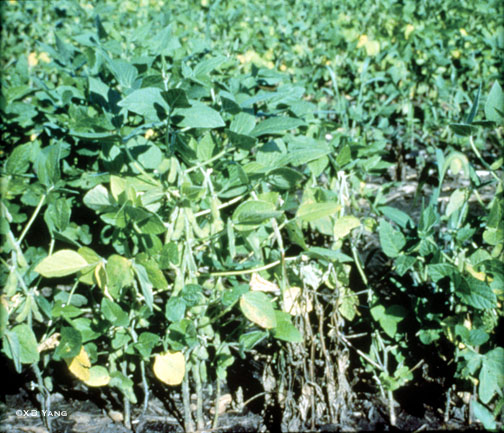Soybean diseases to scout in July
|
Frequent rain and cool temperatures this crop season have created disease-favorable conditions, resulting in the occurrence of several soybean diseases. Some of the diseases are likely to continue to develop in July. This article summarizes the early-season disease problems encountered thus far and provides some answers to commonly asked questions. Bacterial blight and brown spot are common this year. Significantly, bacterial blight has been prevalent in June as cool temperatures and frequent rains favor the development of this disease. There have been many reports on the occurrence of this disease. The disease is caused by Pseudomonas syringae pv glycinea. New lesions of bacterial blight are small, angular, yellow to brown spots on leaves. The centers soon dry out, turn reddish brown to black, and are surrounded by a water-soaked margin bordered by a yellowish green halo, a feature that is lacking in brown spot. Young leaves are most susceptible to the bacterial infection; therefore, the disease is first noticeable on the top of the plant. The angular lesions enlarge and merge to produce large, irregular lesions. The centers of old lesions often drop out, resulting in a ragged appearance of infected leaves. Brown spot can be confused with bacterial blight in the early soybean growth stage. If this fall is wet and cool, the brown spot is likely to be prevalent later in the season as it attacks aging leaves. I will monitor this disease and discuss it in the future. The impact of the two diseases on yield should not be a concern because normally soybean plant will grow out of the diseases unless we have a season similar to 1993.
Phytophthora rotIn the last two weeks, a majority of seedling damping-off samples received by the Iowa State University Plant Disease Clinic were identified as Phytophthora. Current weather conditions are favorable for the development of this disease. The fungus can continue to infect soybeans, into midsummer, causing stem and root rot. More often, infected plants have chocolate brown discoloration on the stem, especially in areas where the plant stand is thin as a result of damping-off. Many of the soybean samples that we received had resistance genes, some with Rps-1k gene. This indicates that a new Phytophthora race has developed. If you find soybean plants from seed that contained Rps-1k resistance genes and were infected with Phytophthora, consider planting varieties with different resistance gene, specifically Rps-6 gene if available, in the future.
Soybean plants infected with Phytophthora. White moldLast year, soybean white mold resurged in some soybean fields in northern Iowa after several years of disappearance. Luckily, the drought stopped the development of this disease. Current cool temperatures and high soil moisture were ideal for the infection of soybean white mold fungus. If the conditions continue until mid-July, the risk increases for soybean fields planted early that had white mold in the past, especially for farms with white mold last year. In the first and second week of July, you will be able to see any white mold mushrooms that emerge. If white mold occurs, it is difficult to say how severely the disease may impact yield this year because the disease has not occurred for years and, therefore, no data is available to estimate inoculum potentials. Finally, don't forget to look for soybean rust during your scout. The disease is moving north from South America and its movement is difficult to predict. Once it arrives in North America, it is expected to be carried by the wind from the southern United States to the northern United States. However, there is also the remote possibility that it could reach the northern states before the southern states. Therefore, early detection of the disease is a key to managing its risk. Keep in mind that other foliar diseases, especially brown spot and bacterial blight, can be mistaken for soybean rust. This article originally appeared on pages 85-86 of the IC-492(15) -- July 12, 2004 issue. Updated 07/11/2004 - 1:00pm
|



